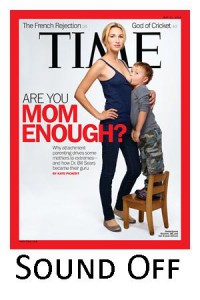By Rita Brhel, managing editor and API leader
 Various parenting approaches are usually categorized as either child-centered or parent-centered, and there is great contention about which is better for both children and parents. Child-centered, critics say, compromises a parent’s sense of balance and may lead to children feeling entitlement. Parent-centered, critics counter, compromises a child’s need for parental attention and attunement.
Various parenting approaches are usually categorized as either child-centered or parent-centered, and there is great contention about which is better for both children and parents. Child-centered, critics say, compromises a parent’s sense of balance and may lead to children feeling entitlement. Parent-centered, critics counter, compromises a child’s need for parental attention and attunement.
But is this polarization, this black-and-white, all-or-nothing thinking, reality? Should we be debating for which is the better of the two “evils”?
The fear centered on Attachment Parenting is that, because it involves a parent to be attuned to her child around the clock, that it must be synonymous with or at least bordering on permissive parenting. Scary music please… Permissive parenting is that style of parenting that conjures thoughts of dread in as many parents as abusive parenting does. Permissive parenting indicates a seriously imbalanced, child-centered parenting style where parents bend to the will of the child in everything, perhaps out of fear of rejection or out of pure indifference, without setting behavioral limits. It can lead to where the parent has no rights to her own sense of self, because the parent will forgo her own needs to satisfy her child’s wants.
The reaction by critics of Attachment Parenting is – instead of understanding the ins and outs of what it indeed means to have a secure parent-child attachment bond – is often to recommend a complete overhaul on the parenting principles: shut the child in the bedroom and let him cry himself to sleep alone, schedule feedings, punish and shame and ignore requests. As if doing the very opposite of their perceived fears is anymore healthy?
Rather than focusing on whether any approach of parenting is child-centered or parent-centered, perhaps we should be looking for the healthy middle ground, where both parents and children are valued equally. This doesn’t mean parents aren’t the authority. And this doesn’t mean that children aren’t expected to having boundaries on their behavior. Children are wired to look to their parents for guidance, but that authority doesn’t need to be harsh.
Attachment Parenting is family-centered. It takes the good components of the child- and parent-centered parenting styles – that children are in need of round-the-clock attunement from their parents but that parents have very real needs for personal balance. Children are treated with the same respect by adults as they are expected to give to adults. They may need more guidance, of course, but I liken it to working in a company with employees of different generations and skill levels: Mid- and high-level workers naturally have more responsibility and freedom than entry level positions, but everyone is treated with the same respect. Good managers do not berate or ignore their employees – they train and give second chances and allow entry level workers to gradually gain more responsibility. We model the character we want to develop. We teach. We try to develop human resources, rather than discharging employees who might otherwise benefit from nurturing. This is good for the company and for the individuals.
A critic may say that children aren’t developmentally at the same level as parents and therefore can’t be treated the same. That’s true that children and adults are obviously at different developmental stages. But they can be treated equally as far as value goes. We are understanding when our spouse or friend or coworker does or says something that hurts our feelings or angers us. We don’t shut them out or yell at them – we talk it through, empathize, work from a position of trust rather than a position of fear that this latest infraction will spell doom for all other interactions with us and others.
Attachment Parenting requires a different way of looking at children. And it requires a very different view of ourselves and how families “should” work. It requires changing our expectations of balance, of educating ourselves on needs versus wants, of seeing the family as a unit, supporting one another, rather than each family member struggling against each other to fill their emotional needs.